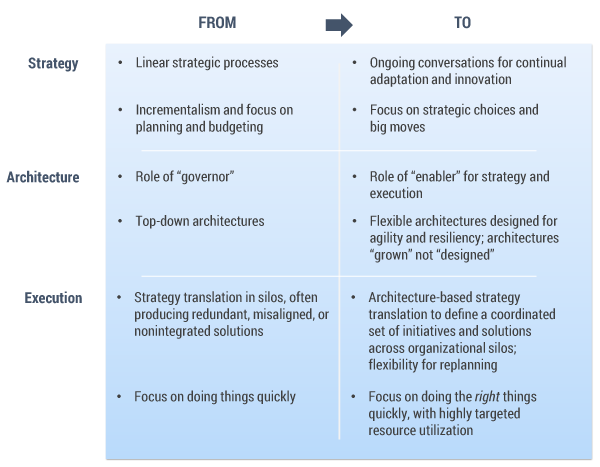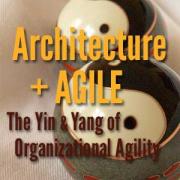CUTTER BUSINESS TECHNOLOGY JOURNAL VOL. 31, NO. 7

According to the principle of yin and yang, all things exist as inseparable and contradictory opposites. In this issue of Cutter Business Technology Journal (CBTJ), we explore the relationship between architecture and organizational agility as a powerful paradox: architecture is the way to agility.
Business agility — the ability of an organization to continually anticipate and react to change in response to major forces such as globalization and technology — is moving from the realm of competitive advantage to a necessity for survival. There have been great advances in improving the agility of execution, and while many organizations are pursuing such approaches, the bigger question remains: how does an organization truly transform to be agile at its core, including with end-to-end strategy execution and employee mindset? Organizations are also grappling with what the introduction of agile execution approaches means to longer-term, big-picture perspectives, such as strategy formulation and architecture. Driven by the realization that business agility is no longer optional for long-term survival, many organizations are looking to understand the depth of what agility really requires and the most effective path for achieving it.
Organizations are living organisms, constantly evolving to adapt to the environment. But today’s environment is calling for a quicker sense of adaptation than ever before. We are shifting far more toward agile mindsets and ways of working. However, agility is not just for execution. Simply speeding up execution does not ensure we are doing the right things; in fact, we could be doing more of the wrong things faster! Quite the contrary, agility is a concept that ripples from strategy through architecture and then to execution.
The way organizations strategize, architect, and execute change needs to further evolve from linear and relatively static to continuous and flexible (see Figure 1). Can we reimagine strategy as an ongoing conversation constantly reacting to the environment, one that truly focuses on strategic choices and big moves — versus an annual process that focuses on planning and budgeting for incremental changes, as is frequently practiced by many organizations today? And what if the results of those strategic conversations continually flowed into an architecture-based approach that translated them into a coordinated set of initiatives across organizational boundaries — instead of each organizational area interpreting the strategy and creating its own projects in silos, hoping that the results do not conflict and will add up to achieve the overarching strategy in the end? And could agile execution approaches be made more successful if they were informed by an architectural direction that defined an agreed-upon, rationalized set of business terms, big-picture business outcomes, and business priorities so that we could focus our precious resources with precision on doing the right things in the most effective way?

This issue of CBTJ demonstrates the seemingly contradictory idea that architecture — something often perceived as structural, static, constraining, governing — is actually the enabler for an organization to become more agile and fluid, from strategy through execution. Architecture is not a box to be checked. On the contrary, it is the mechanism for translating strategies into the right set of coordinated initiatives for execution. It is the bridge between strategy and execution, the bridge that supports the cross-organizational coordination and objective decision making that is so desperately needed in many organizations today.
The traceability provided through the architecture — from strategies and objectives down to the initiatives — also accelerates replanning as business direction shifts because it allows for the ready identification of impacts, enabling organizations to make decisions about what work to stop, pause, or continue. Target architectures can paint a picture of the future and intended business outcomes, helping to create context for people and allowing them to work toward a common vision, regardless of their role. At a foundational level, architecture can also be used as an enterprise lens with which to identify and simplify the business and technology environment in the first place, so that making changes can occur more quickly in the future.
Becoming an agile organization — and leveraging architecture as an enabler for various aspects of it — is a journey that requires deliberate actions and takes time. These changes must be underpinned by strong executive leadership and organizational change management to help shift peoples’ mindsets to embrace continuous change and innovation. Moreover, it may require bold measures to support the change, such as realigning compensation and motivational mechanisms or adjusting investment processes to allow for initiative funding across organizational or portfolio boundaries. Indeed, organizations willing to invest today in reinventing their mindsets and mechanisms for continually anticipating and reacting to change will be the ones ready for tomorrow.
In This Issue
In our first article, Cutter Consortium Fellow William Ulrich and I focus on business architecture and discuss how it can be leveraged as an enabler along the strategy realization path to harmonize the execution of business direction across organizational boundaries and initiatives. We find that organizations struggle with realizing strategies, particularly when those strategies cross business unit, product, and external business domain boundaries. Research shows that more often than not, failure to realize business strategies is not because a given strategy is ill-conceived, but more often due to the scope and impact of those strategies being vague or unknown, especially when they cross organizational boundaries and require collaboration. Using a case study, we highlight how business architecture can be used in strategy formulation, impact analysis, business design, program definition, and agile execution. Business architecture pinpoints the right things to do in the right place at the right time. In fact, we assert that “when business architecture is in place, adopted and leveraged ubiquitously, the gateway for an organization to transform itself into an agile enterprise is in place.”
Next, Yesha Sivan and Raz Heiferman articulate concrete ways in which we can both shift our perspectives and act to “agilify” our organizations. They describe how agile organizations think, what they can do, the abilities they must possess, and even the key technologies they should adopt. They also touch on the important interplay among leadership, culture, business architecture, and digital architecture. As Sivan and Heiferman wisely point out, “Gone are the days that an organization could plan for sustainable competitive advantage and build a five-year (or even three-year) strategic plan. The business environment has become chaotic, dynamic, and disruptive. Enter agility, as the new capability to develop transient competitive advantage with shorter planning and execution cycles. Welcome to the age of ‘agilification.’ ”
Our remaining articles turn to the “Agile” (as in Agile software development) side of agility. Barry O’Reilly and Gar Mac Críosta begin by pointing out how the worlds of Agile and architecture can’t quite fit together. To resolve this, they introduce a new architectural approach, asserting that by “architecting for antifragility, businesses can gain real agility and deliver systems with a higher level of quality.” They describe the challenges of complex systems and then define an Antifragile Systems Design process, which embraces the complexity in building dynamic systems to guide architects to optimize and balance volatility, uncertainty, complexity, and ambiguity on any project. The result of this approach is “a business with a better understanding of its own fragility and a software system capable of bending and meeting the needs of the changing business environment.”
Jan-Willem Sieben, Jan-Paul Fillié, and Cristina Popescu explore Agile architecture and architectural agility and how these two fundamentally different paradigms can reinforce one another. They describe the pitfalls or “anti-patterns” for both enterprise architecture and Agile — and then make a case for how they can be overcome by combining the practices. Based on real-world case studies from several organizations, Sieben, Fillié, and Popescu describe several specific ways in which organizations have combined architecture with Agile thinking and methods to break through the anti-patterns and improve their results.
Next, Bob Galen lays out nine rules of Agile architecture to inform us in how to think about architecture and help us strike the right balance between architecture and agility. He asserts that “software architecture requires balance. Often, you can focus too much on it, creating robust products that miss customer needs or over-engineer solutions. Conversely, especially in Agile contexts, you can under-engineer things and your product efforts can succumb to relentless refactoring rework. So there’s a balance to strike in architecture, no matter what methodology you use to create your software. In Agile contexts, that balance is often lost.” As Galen asserts, this balance comes at the point where you “define, refine, and implement just-enough and just-in-time architecture.” The nine rules are indeed good ones to embrace — practical, grounded in experience, encompassing of the human aspects, and even delivered with levity.
To conclude our issue, Miklós Jánoska provides a perspective on how we can shift architecture from a governor to more of an enabler. As he points out, “Despite the multitude of architecture frameworks and methods, experiencing a smoothly working, pragmatic synergy between delivery teams and the architecture discipline is rare.” He provides insight into common difficulties in Agile projects and then describes how organizations can establish a “non-blocking” architecture governance practice for Agile development teams. The approach leads to organically integrating architecture into the process, into the delivery pipeline, and into the teams’ everyday work. As Jánoska reminds us, “Under the increasing pressure of accelerating marketplaces and rapidly evolving technologies, internal velocity and responsivity become significant differentiating factors. Indeed, responsive, flexible software ecosystems enable high-speed businesses.”
No matter where you are on your journey toward organizational agility, we hope that the articles in this issue give you a new perspective on the art of the possible and on how architecture can be the gateway to a future of continuous adaptation, innovation, and success for your organization.



